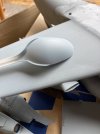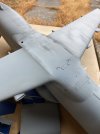Hello to all the more experienced sprayers.
I am currently building the Revell 1:72 A400M Atlas and I am experiencing airbrushing issues (big time). I have had little problem with smaller parts and smaller kits but this is my first large kit and I don't know if some of that is related to it.
I posted before (general chit-chat, I think) and was steered to spraying closer to avoid a powdery finish. Part of the previous problem was also that the ambient temp was too high.
So, I bought some VMS enamel retarder from John's shop, added 10% to the Revell Color Mix and then made up a 1:1 with this combo and Revell No.57 Enamel.
First step was to lay some of it on a spoon and see how it came out...
There did not seem to be any issues.
Next step - put it on the aircraft...
Can I cry now? It just looks terrible.
I paid close attention to my distance from the model - only about 2 inches away (desperately trying to avoid powder)
The ambient is only 18.6C
I noticed the other day that the powder forms around the edge of the cone of deposition so, today, I dialled my pressure down to 10psi to stop it being blasted.
I am out of ideas regarding how to stop this.
Any further suggestions guys from those who have gone through the pain barrier ahead of me?
Yours tearfully,
John
I am currently building the Revell 1:72 A400M Atlas and I am experiencing airbrushing issues (big time). I have had little problem with smaller parts and smaller kits but this is my first large kit and I don't know if some of that is related to it.
I posted before (general chit-chat, I think) and was steered to spraying closer to avoid a powdery finish. Part of the previous problem was also that the ambient temp was too high.
So, I bought some VMS enamel retarder from John's shop, added 10% to the Revell Color Mix and then made up a 1:1 with this combo and Revell No.57 Enamel.
First step was to lay some of it on a spoon and see how it came out...

There did not seem to be any issues.
Next step - put it on the aircraft...

Can I cry now? It just looks terrible.
I paid close attention to my distance from the model - only about 2 inches away (desperately trying to avoid powder)
The ambient is only 18.6C
I noticed the other day that the powder forms around the edge of the cone of deposition so, today, I dialled my pressure down to 10psi to stop it being blasted.
I am out of ideas regarding how to stop this.
Any further suggestions guys from those who have gone through the pain barrier ahead of me?
Yours tearfully,
John


